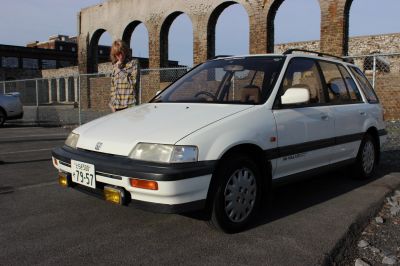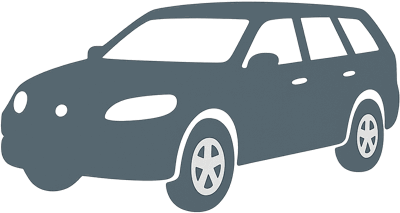 2002 Peugeot 206 SW Dimensions, Size & Specs
2002 Peugeot 206 SW Dimensions, Size & SpecsMeasurements of the 2002 Peugeot 206 SW, engineered for optimal performance and comfort
| Dimensions | |
|---|---|
| Length: | 4028 mm158.6 in13.2 ft |
| Width: | 1652-1673 mm65.0-65.9 in5.4-5.5 ft |
| Height: | 1430-1460 mm56.3-57.5 in4.7-4.8 ft |
| Trunk Capacity: | 313 liter11.1 cu ft |
| Trunk Capacity (Max): | 1136-1365 liter40.1-48.2 cu ft |
| Weight Specifications | |
| Curb Weight: | 990-1120 kg2183-2469 lbs |
| Maximal permitted Weight: | 1485-1611 kg3274-3552 lbs |
| Tire Specifications | |
| Rims Size: |
|
| Tire Sizes: |
|
The Peugeot 206 SW, produced between 2002 and 2007, is a compact station wagon designed to offer practicality combined with the small car agility characteristic of the Peugeot 206 family. Measuring 4028 mm (158.5 inches) in length, this generation delivers a convenient footprint ideal for urban driving and tight parking scenarios, while still providing notable interior versatility. The width ranges from 1652 to 1673 mm (65.0 to 65.9 inches) and the height varies between 1430 and 1460 mm (56.3 to 57.5 inches), dimensions that contribute to a balanced exterior design accommodating comfort and maneuverability. The vehicle's curb weight lies between 990 and 1120 kg (2183 to 2469 lbs), supporting efficient fuel consumption while offering sufficient stability and road presence. Maximum allowable weight ranges from 1485 to 1611 kg (3275 to 3550 lbs), reflecting its practical load-carrying capacity. One of the standout features of the Peugeot 206 SW is its adaptable luggage space. It offers 313 liters (11.05 cubic feet) of cargo capacity with the rear seats in place, which expands impressively to between 1136 and 1365 liters (40.1 to 48.2 cubic feet) when the rear seats are folded down, making it suitable for families or those needing extra cargo room without upgrading to a larger vehicle class. The model typically rides on 14-inch rims, paired with tire options including 175/65R14, 195/55R15, 205/45R16, and others, providing a balance of comfort and handling performance. Overall, the Peugeot 206 SW is a well-rounded station wagon option from the early 2000s, offering compact dimensions with flexible storage, making it an optimal choice for buyers seeking a small estate car with enhanced utility.
Discover the standout features that make the 2002 Peugeot 206 SW a leader in its class
Have a question? Please check our knowledgebase first.
The Peugeot 206 SW station wagon, produced between 2002 and 2007, has exterior dimensions optimized for compact family use. Its length measures 4028 mm (158.5 inches), making it a compact vehicle suitable for urban driving and parking. The width ranges between 1652 mm to 1673 mm (65 to 65.9 inches), depending on specific model variants and equipment. Height varies from 1430 mm to 1460 mm (56.3 to 57.5 inches), balancing enough headroom with a low profile for aerodynamic efficiency. These dimensions make the 206 SW a practical wagon with a fairly small footprint.
The curb weight of the Peugeot 206 SW ranges from 990 kg to 1120 kg (2183 to 2469 pounds), depending on engine variants and trim levels. This relatively light weight supports its agile driving characteristics and fuel efficiency. The vehicle's maximum weight, which includes passengers and cargo, ranges between 1485 kg and 1611 kg (3275 to 3550 pounds). This range offers a good balance between carrying capacity and maintaining driving dynamics.
The Peugeot 206 SW provides a versatile luggage space. With the rear seats upright, it offers a practical 313 liters (about 11 cubic feet) of cargo volume, enough for daily shopping or smaller trips. When the rear seats are folded down, the capacity expands impressively to between 1136 liters and 1365 liters (40.1 to 48.2 cubic feet), depending on the exact configuration. This significant increase transforms the 206 SW from a compact wagon into a vehicle capable of carrying larger loads or bulkier items, making it ideal for family outings and extended travel.
Yes, the Peugeot 206 SW fits comfortably inside a standard residential garage. Typical single-car garage dimensions are approximately 2400-3000 mm (7.9-9.8 feet) wide, 4800-6000 mm (15.7-19.7 feet) deep, and 2100-2400 mm (6.9-7.9 feet) high. With its length of 4028 mm (158.5 inches or 13.2 feet), width of up to 1673 mm (65.9 inches or 5.5 feet), and height up to 1460 mm (57.5 inches or 4.8 feet), this Peugeot fits with ample room to spare for opening doors and maneuvering inside the garage, making it a practical choice for homeowners.
The Peugeot 206 SW is the station wagon variant of the 206 range and thus differs notably in overall length and cargo capacity from the standard 206 hatchback. The 206 SW measures 4028 mm in length (158.5 inches), which is longer than the 206 hatchback by roughly 150-200 mm (6-8 inches), providing additional interior cargo space. The width and height are quite similar to the hatchback, maintaining easy maneuverability. The key difference is in luggage capacity: the 206 SW offers 313 liters (11 cubic feet) with seats up versus the hatchback’s smaller boot, making the SW much more practical for carrying bulky items. This makes the 206 SW a better choice for those needing extra cargo space without moving to a larger vehicle.
The Peugeot 206 SW comes standard with 14-inch rims but offers a variety of tire sizes to suit different driving preferences and conditions. Available tire sizes include 175/65R14, 185/65R14, 195/55R15, 195/55R15H, 205/45R16, and 195/55R15H. These options allow drivers to balance between ride comfort, handling performance, and aesthetic considerations. The variety in tire widths and diameters also enable customization based on weather, road surfaces, and style preferences, making the 206 SW versatile for urban and suburban driving environments.
When compared to other compact station wagons from the early 2000s, such as the Ford Focus Wagon, Volkswagen Golf Variant, or Opel Astra Wagon, the Peugeot 206 SW holds a competitive position in terms of interior space efficiency. While its overall luggage capacity of 313 liters (11 cubic feet) with seats in place is slightly less than some competitors, the rear seats folded capacity ranging from 1136 liters to 1365 liters (40.1 to 48.2 cubic feet) is competitive and practical for families or active lifestyles. The 206 SW's compact exterior dimensions also make it easier to maneuver in tight urban settings compared to slightly larger alternatives, making it an attractive option for buyers wanting a balance between space and city-friendly size.
The Peugeot 206 SW’s height ranges from 1430 mm to 1460 mm (56.3 to 57.5 inches). This moderate height allows for a comfortable cabin environment with adequate headroom for front and rear passengers, even for taller individuals. The relatively low profile compared to larger SUVs contributes to a lower center of gravity, enhancing driving stability and handling without sacrificing intra-cabin space. The height dimension strikes a balance between aerodynamics—helping fuel efficiency—and occupant comfort, ensuring that passengers have a spacious yet compact environment suitable for daily commuting and longer journeys.
The Peugeot 206 SW has a width ranging from 1652 mm to 1673 mm (65 to 65.9 inches), depending on the specific model and optional equipment. This relatively narrow width for a station wagon supports easy driving through narrow city streets and tight parking spaces, a key consideration for urban drivers. The narrow width complements the car’s compact length to offer high maneuverability and ease of handling. Despite the smaller footprint, the design ensures there’s sufficient interior shoulder room for passengers. Overall, the width enhances the vehicle’s practicality, particularly in crowded environments.
The Peugeot 206 SW’s curb weight ranges from 990 kg to 1120 kg (2183 to 2469 pounds), varying with engine size, trim level, and optional features. Lighter trims benefit from better fuel efficiency, quicker acceleration, and nimble handling characteristics. Heavier trims, often equipped with more features or stronger engines, offer improved stability and potentially better ride quality due to added soundproofing or suspension upgrades. This variance allows buyers to choose between a more economical, agile version or a more comfortable, better-equipped variant—tailoring the driving experience to their priorities. Despite these differences, all versions remain relatively lightweight for the category, aiding fuel economy and ease of driving.
Discover similar sized cars.

| Model Year: | 1988 |
|---|---|
| Length: | 4105 mm161.6 in |
| Width: | 1690 mm66.5 in |
| Height: | 1515 mm59.6 in |

| Production: | 2013-2018 |
|---|---|
| Model Year: | 2013 |
| Length: | 4084 mm160.8 in |
| Width: | 1700 mm66.9 in |
| Height: | 1504 mm59.2 in |

| Production: | 2002-2005 |
|---|---|
| Model Year: | 2003 |
| Length: | 4053 mm159.6 in |
| Width: | 1660 mm65.4 in |
| Height: | 1437 mm56.6 in |

| Production: | 2002-2005 |
|---|---|
| Model Year: | 2003 |
| Length: | 4053 mm159.6 in |
| Width: | 1660 mm65.4 in |
| Height: | 1437-1450 mm56.6-57.1 in |
